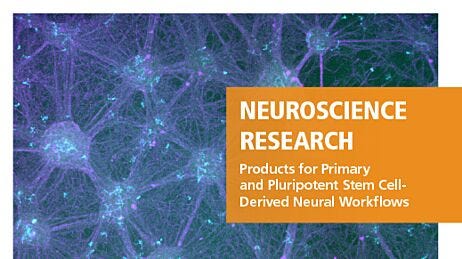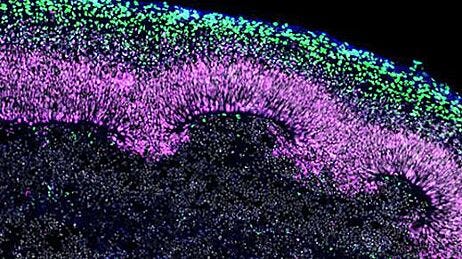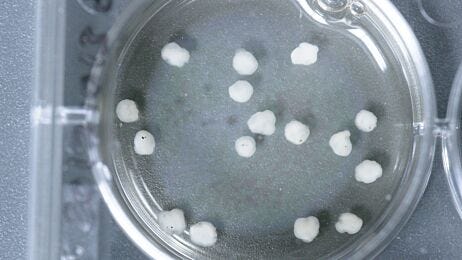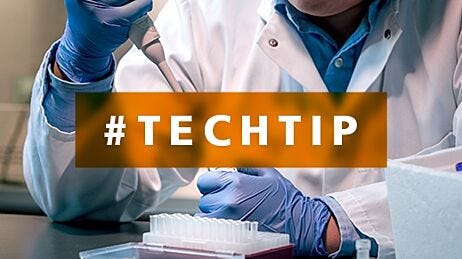Measuring Neuronal Activity in Human Pluripotent Stem Cell-Derived Cerebral Organoids on 3D High-Density Multi-Electrode Arrays
Neural organoids are three-dimensional structures containing a mixture of neural progenitor cells, neurons, and glia with a complex organization mimicking the in vivo arrangement within the developing brain. The presence and physiological arrangement of multiple cell types creates the optimal environment for plentiful, functional synaptic connections. However, the large size and heterogenous cell arrangement between organoids makes it difficult to robustly measure their functional neuronal network activity. Additionally, the spherical shape and large size of organoids can result in poor coupling and low recording quality when placed on the planar surface of multi-electrode array (MEA) plates.
To address these challenges, we outline a method to record neuronal activity from organoids on a multi-electrode array surface in which the 3D pillar structure of the array enhances tissue-electrode coupling in large 3D tissues. We also show how using a high-density (HD) complementary metal-oxide-semiconductor (CMOS)-based technology increases the surface area of the organoid from which electrical signals can be detected, improving the number of recorded cells and allowing the detection of activity changes resulting from pharmacological perturbation. The ability to measure the functional activity of these highly relevant 3D models with enhanced spatial resolution supports robust, reproducible, and predictive data generation for drug discovery, compound screening, and toxicology assays to advance therapeutic development.
Protocol developed in collaboration with a:head bio AG.
Important Notes
- This protocol outlines how to culture and record unguided cerebral organoids on a 3D HD-MEA system.
- The recommended minimum culture period for electrically active organoids is 60 days. STEMdiff™ Cerebral Organoid Maturation Kit can be used to further mature unguided cerebral organoids until Day 60 or for as long as desired (> 365 days).
- If regionalized organoids are preferred, organoids generated using STEMdiff™ Dorsal Forebrain Organoid Differentiation Kit or STEMdiff™ Midbrain Organoid Differentiation Kit can be plated and recorded, with further optimization.
- To achieve consistent neuronal activity, ensure that the organoids display the expected morphology at the time of measurement (refer to the Protocol Diagram in the STEMdiff™ Cerebral Organoid Kit Product Information Sheet).
- For tips and tricks to grow high-quality, electrically active cerebral organoids, refer to this instructional video.
Materials and Reagents
- CorePlate™ 1W-3D 38/60/90 HD-MEA single-well plate (3Brain AG)
- BioCAM DupleX system (3Brain AG)
- BrainWave 5 software with Droid license (3Brain AG)
- STEMdiff™ Cerebral Organoid Kit (Catalog #08570)
- STEMdiff™ Cerebral Organoid Maturation Kit (Catalog #08571)
- BrainPhys™ hPSC Neuron Kit (Catalog #05795)
- BrainPhys™ Neuronal Medium (Catalog #05790)
- NeuroCult™ SM1 Neuronal Supplement (Catalog #05711)
- N2 Supplement-A (Catalog #07152)
- Human Recombinant BDNF (Catalog #78005)
- Human Recombinant GDNF (Catalog #78058)
Protocol
Part I. Preparing the Organoid for 3D HD-MEA Recording
- Generate human cerebral organoids by following the entire protocol outlined in the PIS for STEMdiff™ Cerebral Organoid Kit and mature to at least Day 60.
- The 3D HD-MEA reservoir can hold a maximum volume of 3 mL. To prevent spillage, do not exceed this volume.
- Use sterile technique when performing the following steps.
Medium and Equipment Preparation
- Prepare the CorePlate™ 3D HD-MEA single-well plate as per manufacturer’s instructions. Deep cleaning of the chip and hydrophilic treatment of the chip steps are necessary for mounting the organoid effectively.
- Prepare recording medium by adding the following components to 15 mL of BrainPhys™ Neuronal Medium:
- 300 µL of NeuroCult™ SM1 Neuronal Supplement
- 150 µL of N2 Supplement-A
- 74 µL of 100 mg/mL Dibutyryl-cAMP (final concentration of 1 mM)
- 10.5 µL of 50 µg/mL Ascorbic Acid (final concentration of 200 nM)
- 102 µL of 200 g/L [+] D-glucose solution (final concentration of 10 mM)
- 3 µL of 100 µg/mL BDNF
- 3 µL of 100 µg/mL GDNF
Mix thoroughly.Note: If not used immediately, store the recording medium prepared in Step 2 at 2 - 8°C for up to 2 weeks. Protect from light. Warm recording medium to 37°C before use. - Using a 5 mL pipette, fill the chip reservoir with 2 mL of warm (37°C) recording medium and place the chip into the BioCAM DupleX recording system.
- Set the target temperature to 37°C. The target temperature should remain constant and not fluctuate.
Securing the Organoid to the 3D HD-MEA Chip
- Cover the chip with the CorePlate™ 1W Cap to reduce evaporation of the recording medium.
- Using sterile technique, cut 1.5 - 2 cm off the end of a 1 mL (P1000) pipette tip to increase the bore size. Using the cut pipette tip, transfer a single organoid to a 6 cm culture dish filled with recording medium and carefully transport it to the recording system.
- Remove the CorePlate™ 1W Cap from the chip. Using a 1 mL cut pipette tip, gently collect the organoid from the 6 cm culture dish and place it on top of the chip’s recording area (see Figure 1).
Note: If needed, use a pipette tip to gently displace the recording medium around the organoid to move it to the desired position on top of the 3D HD-MEA. Do not touch the organoid or the microelectrodes.
- Without disturbing the organoid, use a smaller-bore pipette tip (e.g. a 200 µL pipette tip) to remove as much recording medium as possible until the surface of the chip is completely dry (see Figure 1).
Note: It is critical to remove as much recording medium surrounding the organoid as possible. If the surface of the 3D HD-MEA chip is too wet, the organoid will not sufficiently attach.
- Do not disturb the organoid on the 3D HD-MEA chip for approximately 1 minute to allow for attachment.
- Place the sample holder silicon net (previously mounted on the sample holder body) on top of the organoid and gently lower it until the grid contacts the surface of the organoid. This allows for complete immobilization of the organoid for the duration of the recording session, and will not damage the organoid.
- Gently add 1.5 mL of warm (37°C) recording medium to the organoid. If the organoid detaches, remove the sample holder silicon net and repeat steps 5 and 6.
- Cover the chip with the CorePlate™ 1W Cap, to reduce evaporation of the recording medium, and the Mini-Incubator for BioCAM DupleX.
- Connect the gas source (air with CO2 at 5 - 10%) to the Mini-Incubator for BioCAM DupleX with the gas tube. Adjust the output gas pressure to 0.1 bar.
Adjusting Settings and Recording Activity
- On BrainWave 5 software, perform the following adjustments to the BioCAM DupleX settings before starting the recording (see user manual for details):
- Open Recorder mode.
- In the Cockpit area (left panel), select “Brain Organoid / Spheroid” as the biological model in the “Model” bar.
- Based on the expected neuronal activity select Spikes or Field Potentials in the “Optimized for” bar.
- BrainWave 5 will be automatically adjusted with the optimal settings to record the activity selected.
- In the Environmental Chamber Control’s Settings Group located on the Settings Navigator (right panel), set the temperature to 37°C.
- In the Chip Pilot’s Settings Group located on the Settings Navigator (right panel):
- Set the sampling rate to 20 kHz.
- Set the Hardware High-Pass Filter Cut-off to 100 Hz (for spiking activity) or to 5 Hz (for field potentials).
- To begin the data streaming, click the “Play” button on the Cockpit’s Stream Controls (left panel); to begin recording neuronal activity, click the “Start Recording” button instead.

Figure 1. STEMdiff™ Cerebral Organoid Activity Can Be Measured on 3D High-Density Multi-Electrode Array Chip
The 3D HD-MEA can record single-neuron and population activity from whole cerebral organoids generated with STEMdiff™ Cerebral Organoid Kit. The 4096 electrodes consist of 90-micron height pillars with the sensor on the upper surface that penetrate the tissue to record electrical signals. A single Day 150 cerebral organoid is mounted on the 3D HD-MEA chip. The figure includes a digital overlay with dots representing single-unit activity. The collection of single-unit activities over the entire organoid is possible due to the high spatial resolution (60 micron electrode spacing) and high number of sensors simultaneously recorded. HD = high-density; MEA = multi-electrode array
Part II. Inducing and Inhibiting Cerebral Organoid Activity with Pharmacological Compounds
The assay described below is used to assess the effect of an anti-seizure medication (ASM) using a convulsant-induced phenotypic screening model1–3 (Figure 2). Experimental parameters such as organoid culture medium, incubation time, and recording frequency may need to be optimized for the use of different compounds.

Figure 2. Pharmacologically Induced Activity in Cerebral Organoids Can Be Recorded with a 3D High-Density Multi-Electrode Array Chip
An example protocol for pharmacological induction of activity in organoids on the 3D HD-MEA system. Once organoids are terminally differentiated (after Day 30), and on the day of the recording, the medium can be switched into BrainPhys™ medium without SM1 and N2A supplements (step 1) for the baseline recording. The organoids were acclimatized to the media for 90 minutes. Then a recording was performed, followed by a full medium change into convulsant solution (step 2). After an acclimatization period of 90 minutes, a second recording was performed, followed by a second full medium change to introduce the test compound (in this case, 1 mM of anticonvulsant valproic acid). The final recording is performed after a further 90 minutes. HD = high-density; MEA = multi-electrode array; 4-AP = 4-Aminopyridine
- Prepare BrainPhys™ medium without SM1 and N2A supplements by adding the following components to 15 mL of BrainPhys™ Neuronal Medium:
- 150 µL of 100 mg/mL Dibutyryl-cAMP (final concentration of 1 mM)
- 10.5 µL of 50 µg/mL Ascorbic Acid (final concentration of 200 nM)
- 102 µL of 200 g/L [+] D-glucose solution (final concentration of 10 mM)
- 3 µL of 100 µg/mL BDNF
- 3 µL of 100 µg/mL GDNF
Note: BrainPhys™ medium without SM1 and N2A supplements is the same as the recording medium without SM1 and N2A supplements. If you plan to use the recording medium for pharmacological testing, you need to test whether SM1 and N2A supplements interfere with the results.Mix thoroughly.Note: If not used immediately, store protein-free BrainPhys™ medium at 2 - 8°C for up to 2 weeks. Protect from light. Warm to 37°C before use. - Prepare 1.5 mL of BrainPhys™ medium without SM1 and N2A supplements containing the compounds that will be used during steps 6 - 13:
- Convulsant solution: 4-Aminopyridine (4-AP) final concentration of 100 μM)
- Convulsant + ASM solution: 4-AP (100 mM) + Valproic Acid (final concentration of 1 mM)
Note: Dissolve the stock solutions for both 4-AP and valproic acid in water. You can choose the stock concentration that works best for you.
- Prepare the organoid for 3D HD-MEA recording as outlined in the Medium and Equipment Preparation and Securing the Organoid to the 3D HD-MEA Chip sections of Part I. Incubate at 37°C for 90 minutes in 1.5 mL of BrainPhys™ medium without SM1 and N2A supplements.
- Record field potential (FP) activity for 3 minutes.
- Using a 1 mL pipette, gently remove the BrainPhys™ medium without SM1 and N2A supplements from the reservoir and around the chip until only a fine layer of culture medium surrounds the organoid. Proceed immediately to step 6. Do not allow the organoid to dry out.
- Gently add 1.5 mL of warm (37°C) convulsant solution to the chip.
- Cover the chip with the CorePlate™ 1W Cap and the Mini-Incubator for BioCAM DupleX connected to the gas source.
- Incubate for 90 minutes.
- Record FP activity for 3 minutes after the incubation period.
- Using a pipette, gently remove as much convulsant solution as possible from the reservoir and around the chip with a pipette. At this stage, only a fine layer of culture medium surrounds the organoid. Do not let the organoid dry out.
- Immediately add 1.5 mL of warm (37°C) convulsant + ASM solution.
- Cover the chip with the CorePlate™ 1W Cap and the mini-Incubator for BioCAM DupleX connected to the gas source.
- Incubate for 90 minutes.
- Record FP activity for 3 minutes after the incubation period.
Part III. Analysis of Electrophysiological Recording
Organoid recordings can be analyzed with the BrainWave 5 software. To detect the FPs, a low-pass filter at 50Hz should be applied to reduce high-frequency noise. Perform an FP Detection on the filtered data by setting a positive threshold of 90 microV to detect events. All the oscillations overcoming the threshold are considered FPs. To reduce noise only consider the data from the active electrodes within the organoid boundaries and create a Unit Group containing only electrodes with a mean FP rate greater than or equal to 1 FP/minute at baseline. To detect spikes, perform a Precise Timing Spike Detection (PTSD) with a detection level “balanced” and AI-Validation enabled. To identify FPs, consider the data from the active electrodes within the organoid boundaries and create a Unit Group containing only electrodes with a mean field firing rate greater than or equal to 0.5 spike/second at baseline. All statistics must be calculated based on the Unit Group. See Figure 4 for an example of the analyzed data demonstrating an increase in firing rate compared to baseline when the 4-AP is added and the subsequent decrease when the valproic acid is added from 3 different organoids (± 95% confidence interval). These parameters make it possible to detect pharmacological changes in activity across as few as 3 technical replicates.

Figure 3. 3D High-Density Multi-Electrode Array Recording Provides High Surface Area Coverage Allowing Effective Activity Change Detection
Organoids were generated with STEMdiff™ Cerebral Organoid Kit and further matured with STEMdiff™ Cerebral Organoid Maturation Kit (to Day 170). FPs were recorded using the 3D HD-MEA protocol (Part I) before and after application of a chemical convulsant (4-AP, 100 μM). (A) An example FP trace from 3 electrodes along with an overlay of the electrode activity level across the entire organoid tissue is shown. (B) A raster plot of FPs recorded by the 3D electrodes penetrating the organoid showing a mean FP rate greater than or equal to 1 FP/min. The graph shows the presence of activity at a network level in the form of synchronous FPs occurring on almost all the electrodes (vertical yellow highlights). (C, D) An example FP trace and raster plot are shown following 4-AP administration. 4-AP increases FP amplitude and frequency. FP = field potential; HD = high-density; MEA = multi-electrode array; 4-AP = 4-Aminopyridine

Figure 4. Recording Accuracy Allows for Detection of Differences Between Treatment Conditions Even When Using Few Replicates
Convulsant triggered hyperactivity can be treated with clinical anti-seizure medication (ASM). The change in FP firing rate (Hz) was measured in three ~170 Day STEMdiff™ Cerebral Organoids (1, 2, 3) after 4-AP convulsant treatment application, normalized to baseline. Paired electrode analysis was performed and the data is represented with mean +/-95% CI. All organoids exhibit an increase in firing rate following 4-AP treatment (orange bars). When the same organoids are stimulated again with 4-AP in conjunction with the clinically used antiseizure medication Valproic Acid (grey) the increase in activity is reduced compared to 4-AP treatment alone. This difference is observed even at a single organoid level (1, 2, 3). FP = field potential; 4-AP = 4-Aminopyridine
Request Pricing
Thank you for your interest in this product. Please provide us with your contact information and your local representative will contact you with a customized quote. Where appropriate, they can also assist you with a(n):
Estimated delivery time for your area
Product sample or exclusive offer
In-lab demonstration







